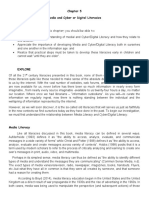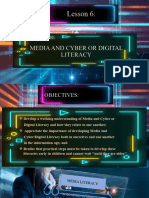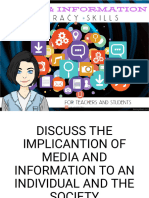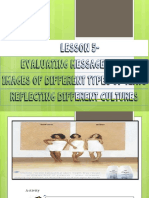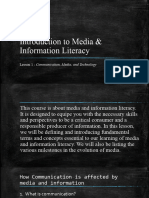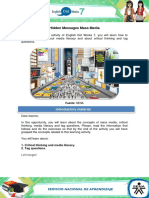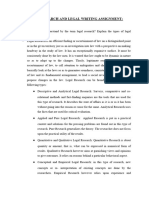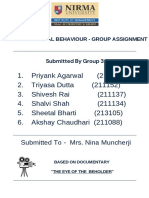BUCAS GRANDE
Brgy. Taruc, Socorro, Surigao del Norte
FOUNDATION
Reporter: JACOBE, Christian Joy E.
Topic: Chapter 5: Media and Cyber or Digital Literacies - Media Literacy
Media and Cyber or Digital Literacies
Good evening, Ma’am D, good evening mga ferson. How are you, guys? Kaya pa? We are now in the Chapter 5:
Media and Cyber or Digital Literacies. In front of you is Christian Joy Elandag Jacobe, the first reporter of tonight’s
video. Before we proceed to the discussion, I’d like to ask a volunteer to read loudly the objectives of this very
important chapter of our course.
OBJECTIVES
At the end of this chapter, you should be able to:
1. develop a working understanding of Media and Cyber or Digital Literacies and how they relate to one another;
2. appreciate the importance of developing Media and Cyber or Digital Literacies both in ourselves and one another in
the information age; and
3. realize that practical steps must be taken to develop these literacies early in children and cannot wait “until they are
older.”
Media Literacy
Before we proceed to Media Literacy, let us first define the words “media” and “literacy”. I know that these
words are not anymore new to you, guys, to us, but LABAN.
Media is a broad term.
Media is the plural form of medium, which describes any channel of communication. This can include
anything from printed paper to digital data, and encompasses art, news, educational content and numerous
other forms of information. Literacy is the competence or knowledge in a specified area.
Like all the literacies discussed from chapter 1 to chapter 4, media literacy can be defined in several ways.
According to Aufderheide (1993), media literacy is the ability to access, analyze, evaluate, and communicate
messages in a wide variety of forms.
While Christ and Potter (1998) desfines it as “the ability to access, analyze, evaluate, and create messages
accross a variety of contexts.”
Hobbs (1998) posits that it is a term used by modern scholars to refer to the process of critically analyzing and
learning to create one’s own messages in print, audio, and multimedia.
These definitions are accepted, the definitions of media literacy, handed down from this year until today.
Perhaps in its simplest sense, media litreracy can thus be defined as “the ability to identify different types of
media and understand the messages they are communicating.” Identify the different types of media. What
are those? TELEVISION, RADIO, NEWSPAPER, MAGAZINE, BOOKS, HANDOUTS, FLYERS, etc.
But what they all have in common is that they were all created by someone (producer), and that producer as
a reason for creating them.
According to Boyd (2004), media litearcy education began in the United States and United Kingdom as a
direct result of war propaganda in the 1930s and the rise of adveritisng in the 1960s.
In both cases, media was being used to manipulate the perspective of those exposed to it, thereby giving rise
to the need to educate people on how to detect the biases, falsehoods, and half-truths depicted in print, radio,
and television. That is why it is very important to have the literacy in media in order for us to detect, to
identify biases, falsehoods, and ekis information. Especially that nowadays, fake news bisan asa ikita.
Facebook, forums, radio, television, etc. Basta kay sa media, nagkanat. And too pod diretso tong mga
nakabasa without thinking, without investigating, agad agad ni share and marites. Or wala lang jod siyay
Media Literacy? Remember, media litearcy is the ability to apply critical thinking skills to the messages,
signs, and symbols transmitted though mass media. You know what, it is very easy to manipulate
consumers’ perceptions on the issues both political and commercial. So we must have the media literacy
para iwas fake news.
A few generations ago, our culture’s storytellers were people – family, friends, and others in our community.
For many people today, the most powerful storytellers are television, movies, music, video games, and the Internet.
Whether we admit it or not, but all of us are affected by advertising, news, movies, pop music, video games, and other
forms of media. That’s why media are such a powerful cultural force, and why the media industry is such big
business.
� Advertising tries to get us to buy products. To do this, they use specific techniques , we call “the language of
persuasion.”
The “hidden message” or “subtext” is your interpretation of a piece of media. The subtext is not actually
heard or seen; it is the meaning we create from the text in our own minds after viewing or listening to it.
Subtext, it is the meaning we create from the text in our minds after viewing it. That is why if you are media literate,
it’s somehow not hard for you to interpret, understand, or analyze a piece of media. And if you’re not, LABANNNN.
Possible subtexts include:
Athletes drink milk.
Athletes can only perform well by drinking milk.
Athletes want you to drink milk.
If you drink milk you will be athletic.
Famous people drink milk.
If you drink milk, you’ll be famous, too.
At the 1993 Media Literacy National Leadership Conference, it did identify five essential concepts necessary for any
analysis of media message:
1. Media messages are constructed.
2. Media messages are produced with economic, social, political, historical, and aesthetic contents.
3. The interpretative meaning-making processes involved in message reception consists of an interaction
between the reader, the text, and the culture.
4. Media has unique “languages,” characteristics which typicaly various forms, genres, and symbol systems of
communication.
5. Media representation play a role in people’s understanding of social reality.
These five essential concepts identified at the conference should be at the mind of the consumers for any
analysis or understanding of media messages. Who created this message? Created by someone or the
producer. Did the producer create the media just to fun? Just for amusement? REMEMBER, most media
messages are organized to gain profit and/or power. That is why media messages are constructed using a
creative langauge para ma-attract ang attention sa consumers.
What these five concepts boil down to is that while the producer of a particular media has an intended meaning
behind the communication, what actually gets communicated to the consumers depends not only on the media itself,
but also on the consumers themselves and on their respective cultures. The consumers’ perceived meaning is what
then develops into how people understand social reality.
An immediate example of this is the media portrayal of Mindanao. Because
so little good news coming from the island is communicated by the news
networks, the average Filipino - who might never have been to Mindanao -
comes to believe that the entire island is involved in armed conflict, that
anyone from Mindanao is somehow involved in the conflict, and therefore
(understandably) refuses to go there, nor allow any of his or her relatives to do
so. It is unlikely, that this was the news media's intention, but it is the viewer's
interpretation that ultimately determined his or her beliefs and behavior.
QUESTIONS
1. Do you agree that “We have entered the information age? – According to Robert Darnton, “Every age was an
age of information, each in its own way and according to the available media.
2. Why is media literacy important to students? - Media literacy allows students to draw on their experience of
media forms and connect it to classroom activities.
3.




